Leadership and Management Report: STO and Dhiraagu Case Study Analysis
VerifiedAdded on 2021/02/08
|12
|2467
|6291
Report
AI Summary
This report delves into the core concepts of leadership and management, examining the functions, tasks, and roles of managers. It differentiates between leadership and management, emphasizing the importance of integrating both for optimal results. The report includes a literature review covering managerial functions, effective manager characteristics, and various leadership styles such as transactional, transformational, democratic, and autocratic leadership. It presents a case study analysis of two organizations, State Trading Organization (STO) and Dhiraagu, evaluating their adopted leadership styles and managerial practices through semi-structured interviews. The findings reveal the adoption of transformational and transactional leadership in Dhiraagu, while STO emphasizes democratic leadership. The report concludes that a blend of leadership and management skills is crucial for organizational success, advocating for strategies to develop professionals and foster a supportive working environment.
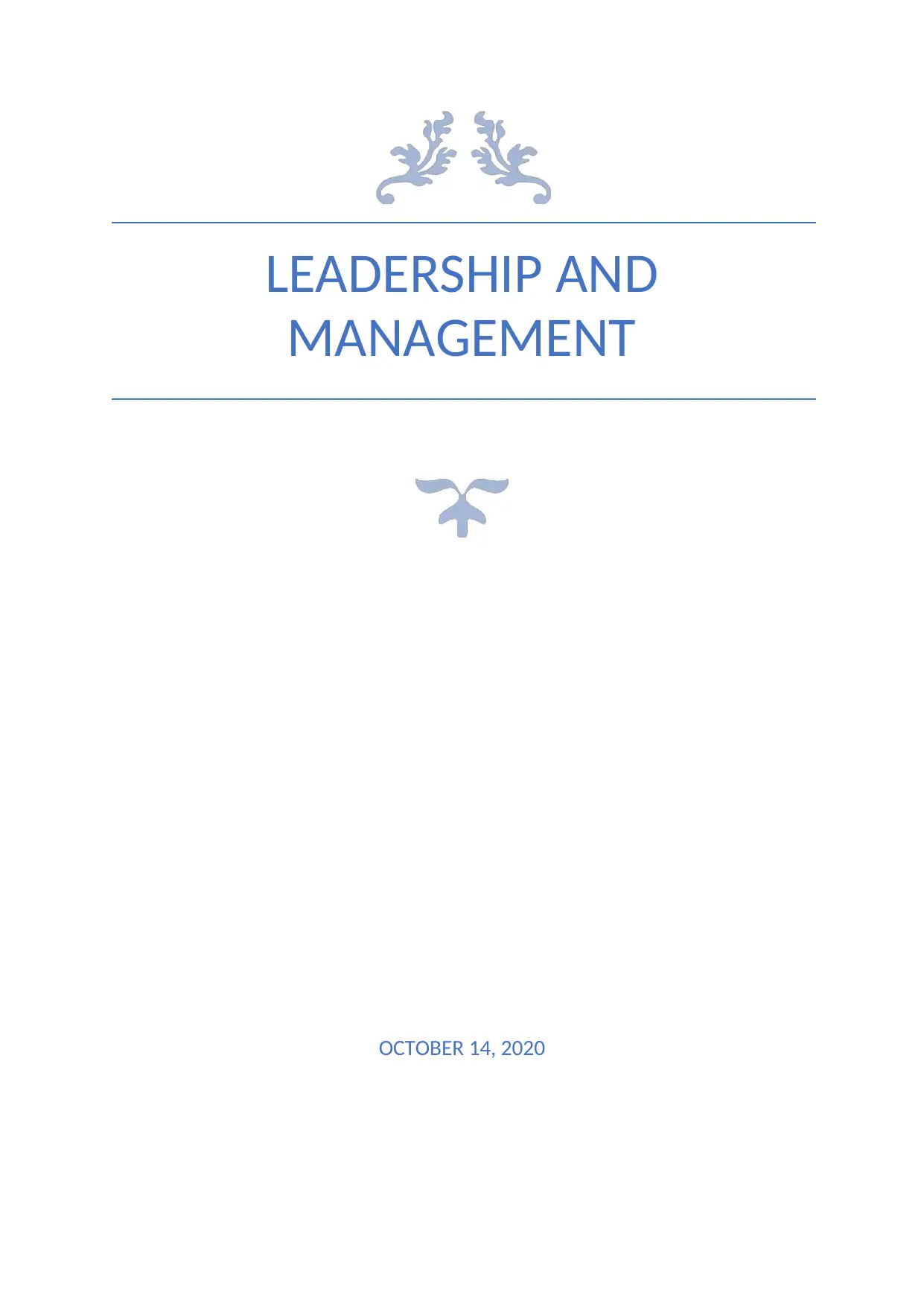
LEADERSHIP AND
MANAGEMENT
OCTOBER 14, 2020
MANAGEMENT
OCTOBER 14, 2020
Paraphrase This Document
Need a fresh take? Get an instant paraphrase of this document with our AI Paraphraser
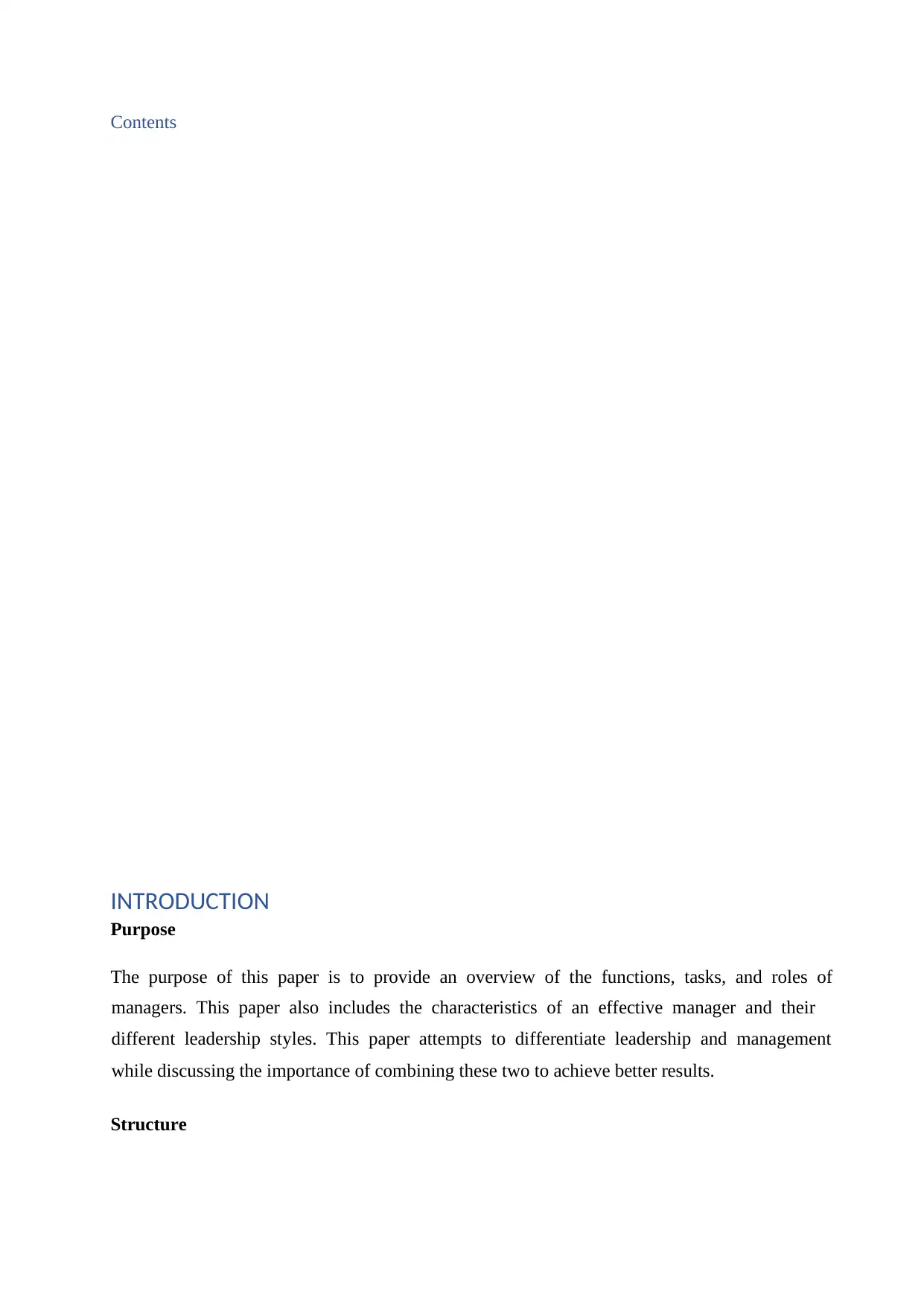
Contents
INTRODUCTION
Purpose
The purpose of this paper is to provide an overview of the functions, tasks, and roles of
managers. This paper also includes the characteristics of an effective manager and their
different leadership styles. This paper attempts to differentiate leadership and management
while discussing the importance of combining these two to achieve better results.
Structure
INTRODUCTION
Purpose
The purpose of this paper is to provide an overview of the functions, tasks, and roles of
managers. This paper also includes the characteristics of an effective manager and their
different leadership styles. This paper attempts to differentiate leadership and management
while discussing the importance of combining these two to achieve better results.
Structure
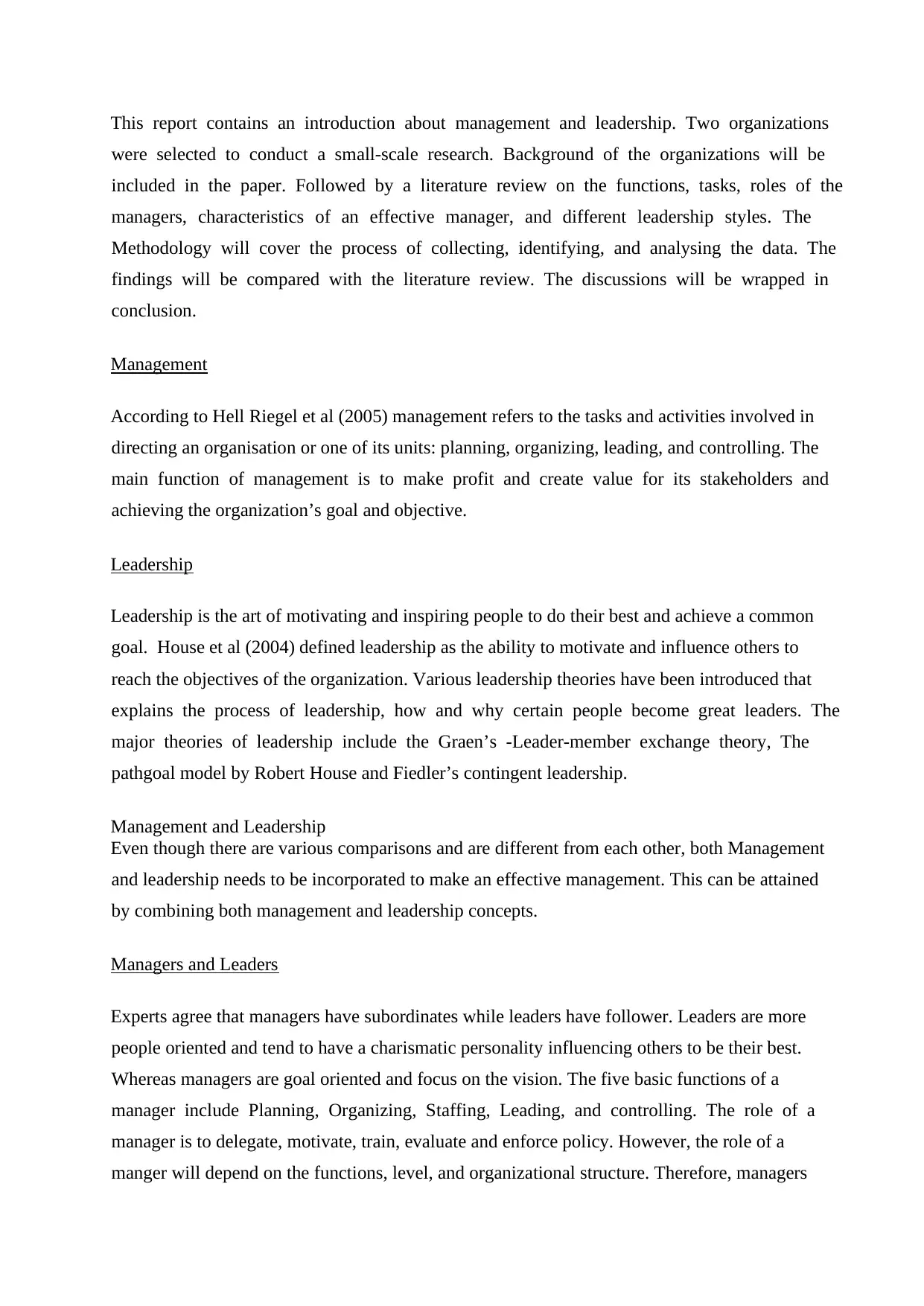
This report contains an introduction about management and leadership. Two organizations
were selected to conduct a small-scale research. Background of the organizations will be
included in the paper. Followed by a literature review on the functions, tasks, roles of the
managers, characteristics of an effective manager, and different leadership styles. The
Methodology will cover the process of collecting, identifying, and analysing the data. The
findings will be compared with the literature review. The discussions will be wrapped in
conclusion.
Management
According to Hell Riegel et al (2005) management refers to the tasks and activities involved in
directing an organisation or one of its units: planning, organizing, leading, and controlling. The
main function of management is to make profit and create value for its stakeholders and
achieving the organization’s goal and objective.
Leadership
Leadership is the art of motivating and inspiring people to do their best and achieve a common
goal. House et al (2004) defined leadership as the ability to motivate and influence others to
reach the objectives of the organization. Various leadership theories have been introduced that
explains the process of leadership, how and why certain people become great leaders. The
major theories of leadership include the Graen’s -Leader-member exchange theory, The
pathgoal model by Robert House and Fiedler’s contingent leadership.
Management and Leadership
Even though there are various comparisons and are different from each other, both Management
and leadership needs to be incorporated to make an effective management. This can be attained
by combining both management and leadership concepts.
Managers and Leaders
Experts agree that managers have subordinates while leaders have follower. Leaders are more
people oriented and tend to have a charismatic personality influencing others to be their best.
Whereas managers are goal oriented and focus on the vision. The five basic functions of a
manager include Planning, Organizing, Staffing, Leading, and controlling. The role of a
manager is to delegate, motivate, train, evaluate and enforce policy. However, the role of a
manger will depend on the functions, level, and organizational structure. Therefore, managers
were selected to conduct a small-scale research. Background of the organizations will be
included in the paper. Followed by a literature review on the functions, tasks, roles of the
managers, characteristics of an effective manager, and different leadership styles. The
Methodology will cover the process of collecting, identifying, and analysing the data. The
findings will be compared with the literature review. The discussions will be wrapped in
conclusion.
Management
According to Hell Riegel et al (2005) management refers to the tasks and activities involved in
directing an organisation or one of its units: planning, organizing, leading, and controlling. The
main function of management is to make profit and create value for its stakeholders and
achieving the organization’s goal and objective.
Leadership
Leadership is the art of motivating and inspiring people to do their best and achieve a common
goal. House et al (2004) defined leadership as the ability to motivate and influence others to
reach the objectives of the organization. Various leadership theories have been introduced that
explains the process of leadership, how and why certain people become great leaders. The
major theories of leadership include the Graen’s -Leader-member exchange theory, The
pathgoal model by Robert House and Fiedler’s contingent leadership.
Management and Leadership
Even though there are various comparisons and are different from each other, both Management
and leadership needs to be incorporated to make an effective management. This can be attained
by combining both management and leadership concepts.
Managers and Leaders
Experts agree that managers have subordinates while leaders have follower. Leaders are more
people oriented and tend to have a charismatic personality influencing others to be their best.
Whereas managers are goal oriented and focus on the vision. The five basic functions of a
manager include Planning, Organizing, Staffing, Leading, and controlling. The role of a
manager is to delegate, motivate, train, evaluate and enforce policy. However, the role of a
manger will depend on the functions, level, and organizational structure. Therefore, managers
⊘ This is a preview!⊘
Do you want full access?
Subscribe today to unlock all pages.

Trusted by 1+ million students worldwide
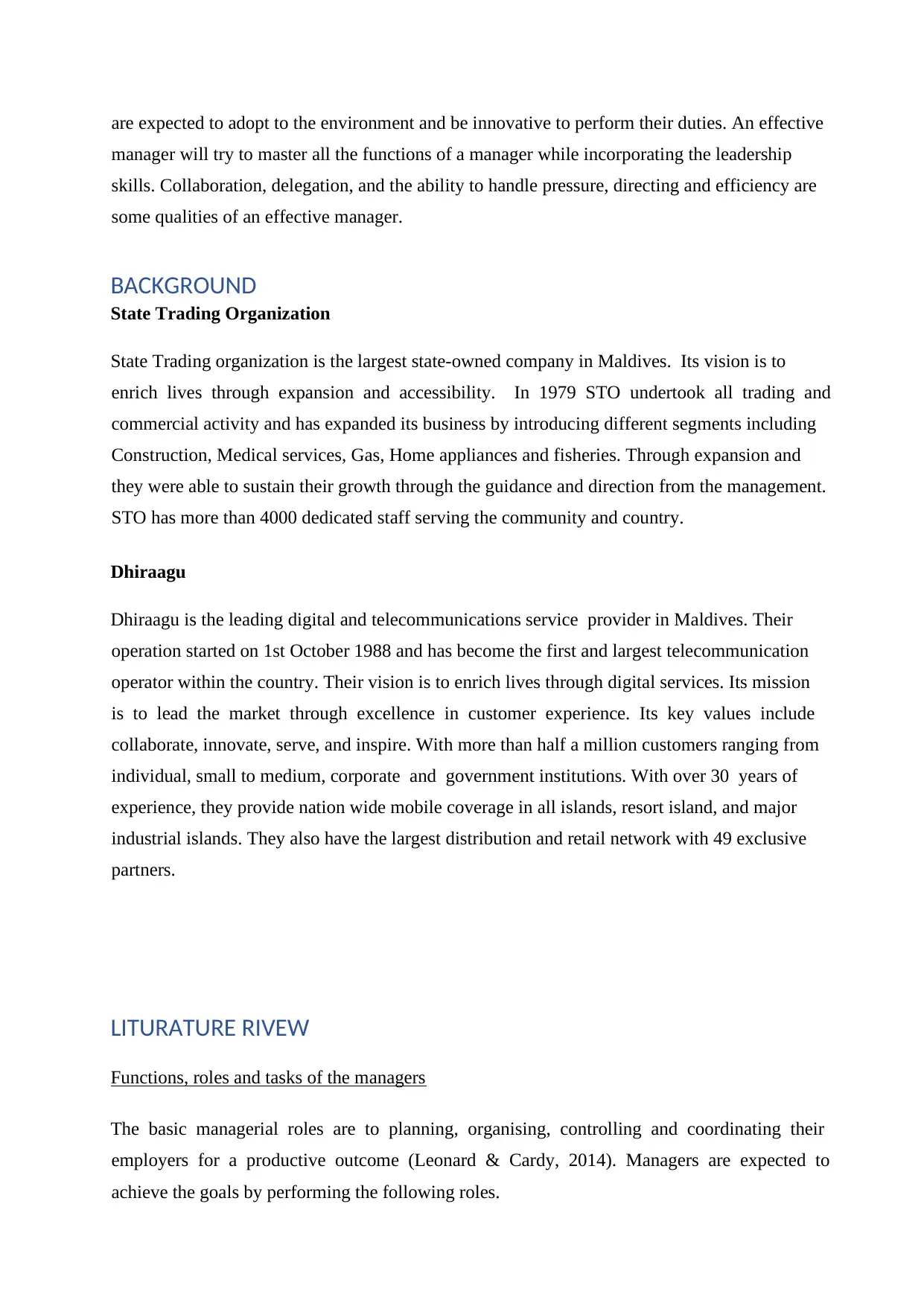
are expected to adopt to the environment and be innovative to perform their duties. An effective
manager will try to master all the functions of a manager while incorporating the leadership
skills. Collaboration, delegation, and the ability to handle pressure, directing and efficiency are
some qualities of an effective manager.
BACKGROUND
State Trading Organization
State Trading organization is the largest state-owned company in Maldives. Its vision is to
enrich lives through expansion and accessibility. In 1979 STO undertook all trading and
commercial activity and has expanded its business by introducing different segments including
Construction, Medical services, Gas, Home appliances and fisheries. Through expansion and
they were able to sustain their growth through the guidance and direction from the management.
STO has more than 4000 dedicated staff serving the community and country.
Dhiraagu
Dhiraagu is the leading digital and telecommunications service provider in Maldives. Their
operation started on 1st October 1988 and has become the first and largest telecommunication
operator within the country. Their vision is to enrich lives through digital services. Its mission
is to lead the market through excellence in customer experience. Its key values include
collaborate, innovate, serve, and inspire. With more than half a million customers ranging from
individual, small to medium, corporate and government institutions. With over 30 years of
experience, they provide nation wide mobile coverage in all islands, resort island, and major
industrial islands. They also have the largest distribution and retail network with 49 exclusive
partners.
LITURATURE RIVEW
Functions, roles and tasks of the managers
The basic managerial roles are to planning, organising, controlling and coordinating their
employers for a productive outcome (Leonard & Cardy, 2014). Managers are expected to
achieve the goals by performing the following roles.
manager will try to master all the functions of a manager while incorporating the leadership
skills. Collaboration, delegation, and the ability to handle pressure, directing and efficiency are
some qualities of an effective manager.
BACKGROUND
State Trading Organization
State Trading organization is the largest state-owned company in Maldives. Its vision is to
enrich lives through expansion and accessibility. In 1979 STO undertook all trading and
commercial activity and has expanded its business by introducing different segments including
Construction, Medical services, Gas, Home appliances and fisheries. Through expansion and
they were able to sustain their growth through the guidance and direction from the management.
STO has more than 4000 dedicated staff serving the community and country.
Dhiraagu
Dhiraagu is the leading digital and telecommunications service provider in Maldives. Their
operation started on 1st October 1988 and has become the first and largest telecommunication
operator within the country. Their vision is to enrich lives through digital services. Its mission
is to lead the market through excellence in customer experience. Its key values include
collaborate, innovate, serve, and inspire. With more than half a million customers ranging from
individual, small to medium, corporate and government institutions. With over 30 years of
experience, they provide nation wide mobile coverage in all islands, resort island, and major
industrial islands. They also have the largest distribution and retail network with 49 exclusive
partners.
LITURATURE RIVEW
Functions, roles and tasks of the managers
The basic managerial roles are to planning, organising, controlling and coordinating their
employers for a productive outcome (Leonard & Cardy, 2014). Managers are expected to
achieve the goals by performing the following roles.
Paraphrase This Document
Need a fresh take? Get an instant paraphrase of this document with our AI Paraphraser
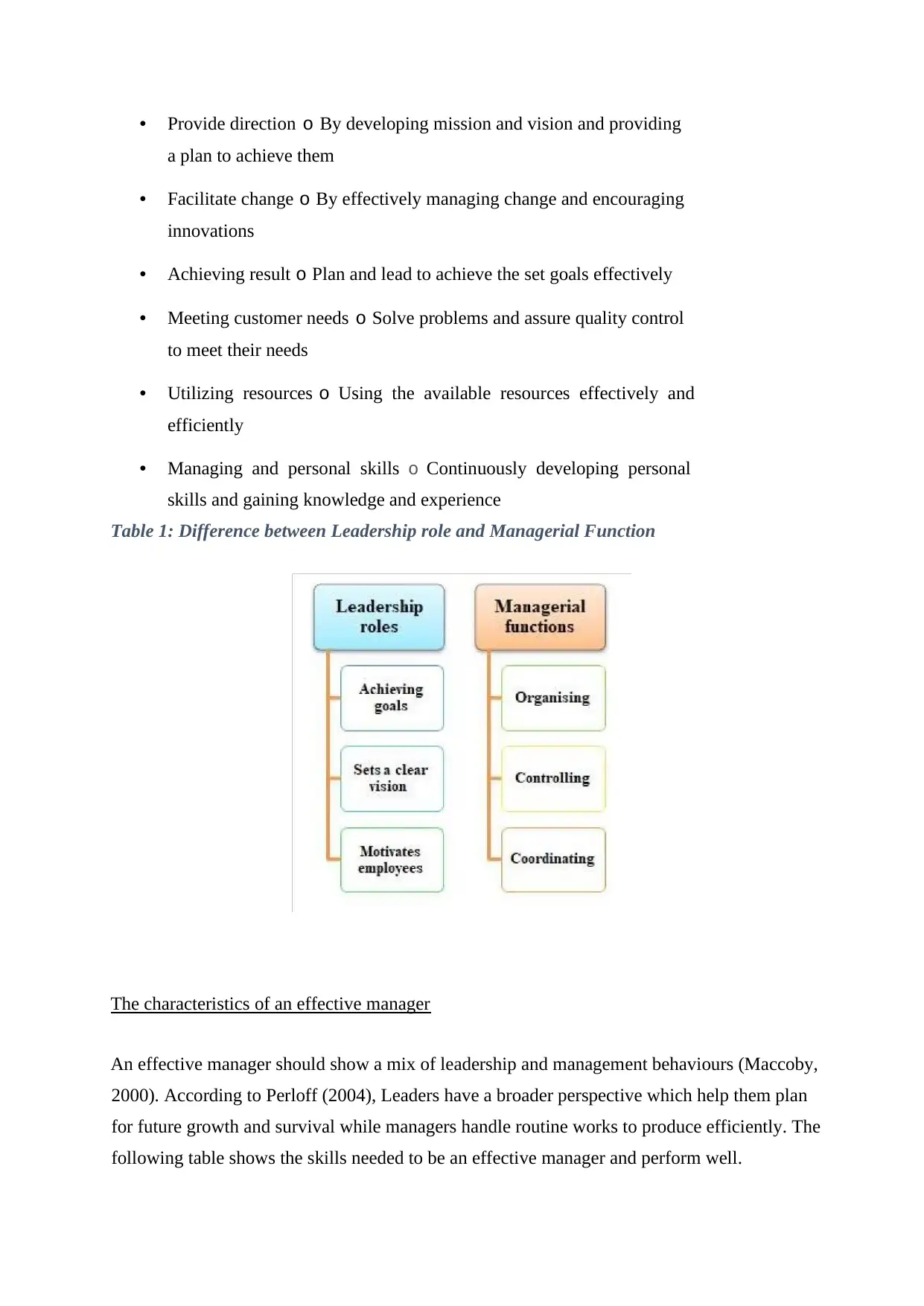
• Provide direction o By developing mission and vision and providing
a plan to achieve them
• Facilitate change o By effectively managing change and encouraging
innovations
• Achieving result o Plan and lead to achieve the set goals effectively
• Meeting customer needs o Solve problems and assure quality control
to meet their needs
• Utilizing resources o Using the available resources effectively and
efficiently
• Managing and personal skills o Continuously developing personal
skills and gaining knowledge and experience
Table 1: Difference between Leadership role and Managerial Function
The characteristics of an effective manager
An effective manager should show a mix of leadership and management behaviours (Maccoby,
2000). According to Perloff (2004), Leaders have a broader perspective which help them plan
for future growth and survival while managers handle routine works to produce efficiently. The
following table shows the skills needed to be an effective manager and perform well.
a plan to achieve them
• Facilitate change o By effectively managing change and encouraging
innovations
• Achieving result o Plan and lead to achieve the set goals effectively
• Meeting customer needs o Solve problems and assure quality control
to meet their needs
• Utilizing resources o Using the available resources effectively and
efficiently
• Managing and personal skills o Continuously developing personal
skills and gaining knowledge and experience
Table 1: Difference between Leadership role and Managerial Function
The characteristics of an effective manager
An effective manager should show a mix of leadership and management behaviours (Maccoby,
2000). According to Perloff (2004), Leaders have a broader perspective which help them plan
for future growth and survival while managers handle routine works to produce efficiently. The
following table shows the skills needed to be an effective manager and perform well.
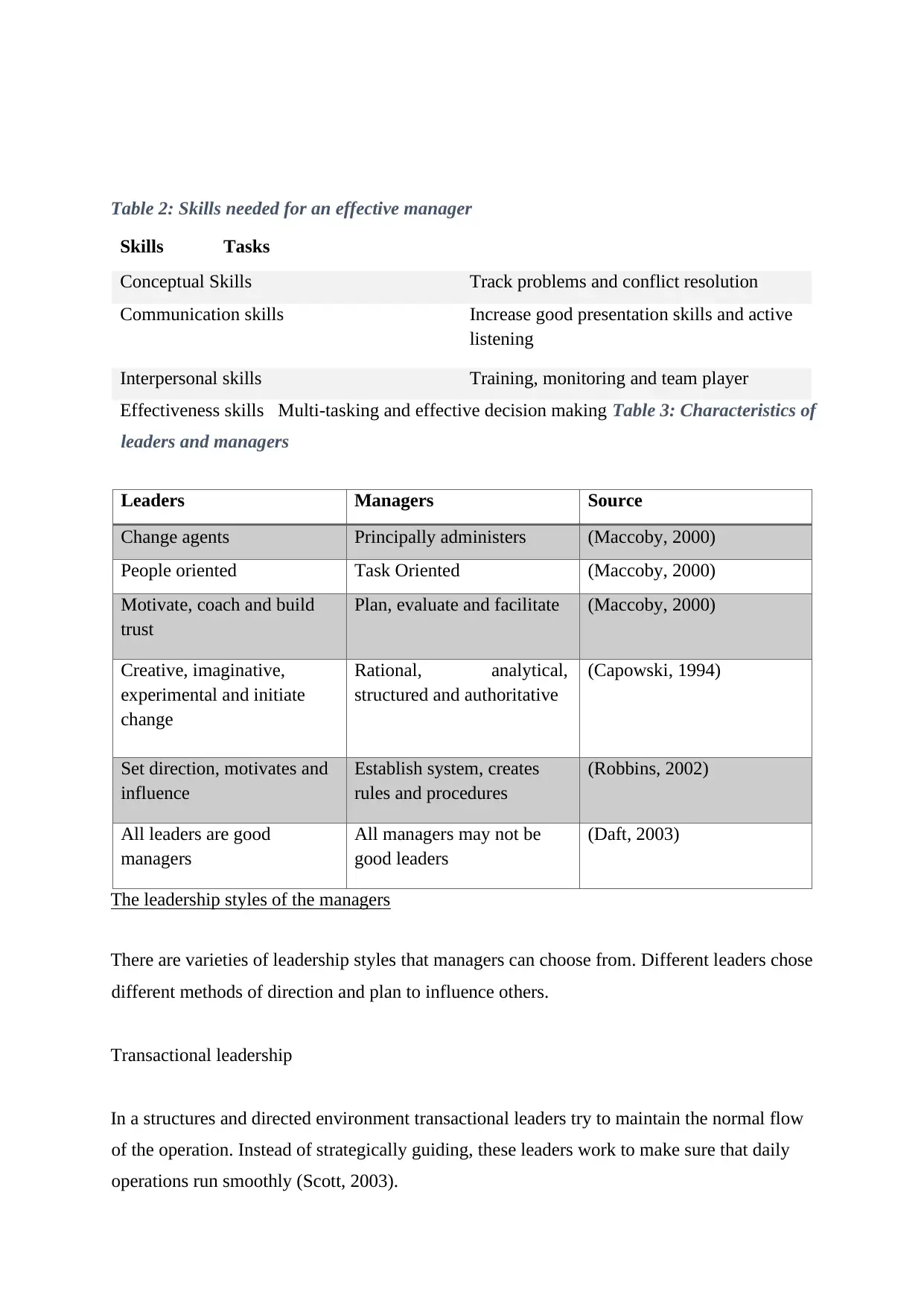
Table 2: Skills needed for an effective manager
Skills Tasks
Conceptual Skills Track problems and conflict resolution
Communication skills Increase good presentation skills and active
listening
Interpersonal skills Training, monitoring and team player
Effectiveness skills Multi-tasking and effective decision making Table 3: Characteristics of
leaders and managers
Leaders Managers Source
Change agents Principally administers (Maccoby, 2000)
People oriented Task Oriented (Maccoby, 2000)
Motivate, coach and build
trust
Plan, evaluate and facilitate (Maccoby, 2000)
Creative, imaginative,
experimental and initiate
change
Rational, analytical,
structured and authoritative
(Capowski, 1994)
Set direction, motivates and
influence
Establish system, creates
rules and procedures
(Robbins, 2002)
All leaders are good
managers
All managers may not be
good leaders
(Daft, 2003)
The leadership styles of the managers
There are varieties of leadership styles that managers can choose from. Different leaders chose
different methods of direction and plan to influence others.
Transactional leadership
In a structures and directed environment transactional leaders try to maintain the normal flow
of the operation. Instead of strategically guiding, these leaders work to make sure that daily
operations run smoothly (Scott, 2003).
Skills Tasks
Conceptual Skills Track problems and conflict resolution
Communication skills Increase good presentation skills and active
listening
Interpersonal skills Training, monitoring and team player
Effectiveness skills Multi-tasking and effective decision making Table 3: Characteristics of
leaders and managers
Leaders Managers Source
Change agents Principally administers (Maccoby, 2000)
People oriented Task Oriented (Maccoby, 2000)
Motivate, coach and build
trust
Plan, evaluate and facilitate (Maccoby, 2000)
Creative, imaginative,
experimental and initiate
change
Rational, analytical,
structured and authoritative
(Capowski, 1994)
Set direction, motivates and
influence
Establish system, creates
rules and procedures
(Robbins, 2002)
All leaders are good
managers
All managers may not be
good leaders
(Daft, 2003)
The leadership styles of the managers
There are varieties of leadership styles that managers can choose from. Different leaders chose
different methods of direction and plan to influence others.
Transactional leadership
In a structures and directed environment transactional leaders try to maintain the normal flow
of the operation. Instead of strategically guiding, these leaders work to make sure that daily
operations run smoothly (Scott, 2003).
⊘ This is a preview!⊘
Do you want full access?
Subscribe today to unlock all pages.

Trusted by 1+ million students worldwide
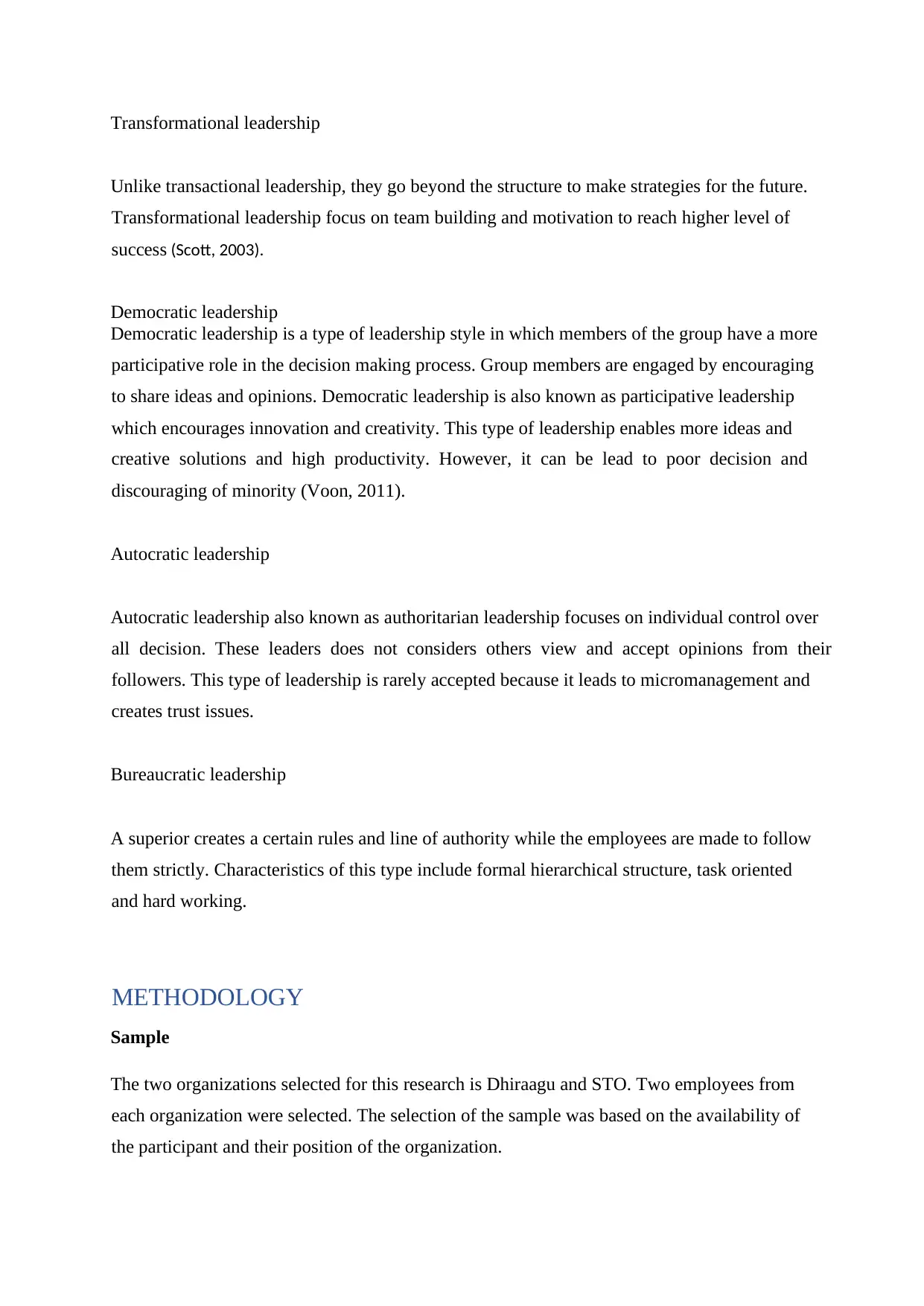
Transformational leadership
Unlike transactional leadership, they go beyond the structure to make strategies for the future.
Transformational leadership focus on team building and motivation to reach higher level of
success (Scott, 2003).
Democratic leadership
Democratic leadership is a type of leadership style in which members of the group have a more
participative role in the decision making process. Group members are engaged by encouraging
to share ideas and opinions. Democratic leadership is also known as participative leadership
which encourages innovation and creativity. This type of leadership enables more ideas and
creative solutions and high productivity. However, it can be lead to poor decision and
discouraging of minority (Voon, 2011).
Autocratic leadership
Autocratic leadership also known as authoritarian leadership focuses on individual control over
all decision. These leaders does not considers others view and accept opinions from their
followers. This type of leadership is rarely accepted because it leads to micromanagement and
creates trust issues.
Bureaucratic leadership
A superior creates a certain rules and line of authority while the employees are made to follow
them strictly. Characteristics of this type include formal hierarchical structure, task oriented
and hard working.
METHODOLOGY
Sample
The two organizations selected for this research is Dhiraagu and STO. Two employees from
each organization were selected. The selection of the sample was based on the availability of
the participant and their position of the organization.
Unlike transactional leadership, they go beyond the structure to make strategies for the future.
Transformational leadership focus on team building and motivation to reach higher level of
success (Scott, 2003).
Democratic leadership
Democratic leadership is a type of leadership style in which members of the group have a more
participative role in the decision making process. Group members are engaged by encouraging
to share ideas and opinions. Democratic leadership is also known as participative leadership
which encourages innovation and creativity. This type of leadership enables more ideas and
creative solutions and high productivity. However, it can be lead to poor decision and
discouraging of minority (Voon, 2011).
Autocratic leadership
Autocratic leadership also known as authoritarian leadership focuses on individual control over
all decision. These leaders does not considers others view and accept opinions from their
followers. This type of leadership is rarely accepted because it leads to micromanagement and
creates trust issues.
Bureaucratic leadership
A superior creates a certain rules and line of authority while the employees are made to follow
them strictly. Characteristics of this type include formal hierarchical structure, task oriented
and hard working.
METHODOLOGY
Sample
The two organizations selected for this research is Dhiraagu and STO. Two employees from
each organization were selected. The selection of the sample was based on the availability of
the participant and their position of the organization.
Paraphrase This Document
Need a fresh take? Get an instant paraphrase of this document with our AI Paraphraser
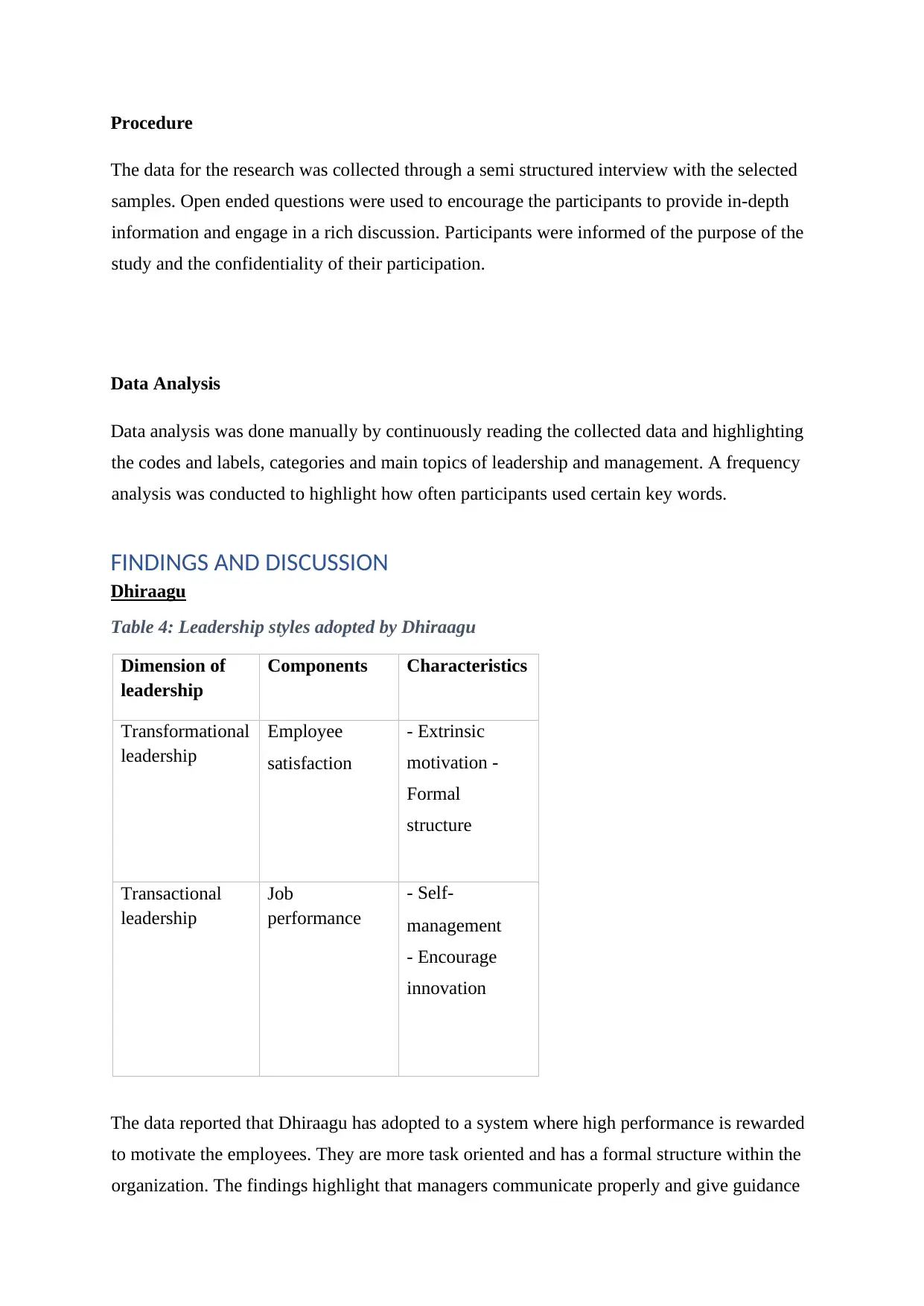
Procedure
The data for the research was collected through a semi structured interview with the selected
samples. Open ended questions were used to encourage the participants to provide in-depth
information and engage in a rich discussion. Participants were informed of the purpose of the
study and the confidentiality of their participation.
Data Analysis
Data analysis was done manually by continuously reading the collected data and highlighting
the codes and labels, categories and main topics of leadership and management. A frequency
analysis was conducted to highlight how often participants used certain key words.
FINDINGS AND DISCUSSION
Dhiraagu
Table 4: Leadership styles adopted by Dhiraagu
Dimension of
leadership
Components Characteristics
Transformational
leadership
Employee
satisfaction
- Extrinsic
motivation -
Formal
structure
Transactional
leadership
Job
performance
- Self-
management
- Encourage
innovation
The data reported that Dhiraagu has adopted to a system where high performance is rewarded
to motivate the employees. They are more task oriented and has a formal structure within the
organization. The findings highlight that managers communicate properly and give guidance
The data for the research was collected through a semi structured interview with the selected
samples. Open ended questions were used to encourage the participants to provide in-depth
information and engage in a rich discussion. Participants were informed of the purpose of the
study and the confidentiality of their participation.
Data Analysis
Data analysis was done manually by continuously reading the collected data and highlighting
the codes and labels, categories and main topics of leadership and management. A frequency
analysis was conducted to highlight how often participants used certain key words.
FINDINGS AND DISCUSSION
Dhiraagu
Table 4: Leadership styles adopted by Dhiraagu
Dimension of
leadership
Components Characteristics
Transformational
leadership
Employee
satisfaction
- Extrinsic
motivation -
Formal
structure
Transactional
leadership
Job
performance
- Self-
management
- Encourage
innovation
The data reported that Dhiraagu has adopted to a system where high performance is rewarded
to motivate the employees. They are more task oriented and has a formal structure within the
organization. The findings highlight that managers communicate properly and give guidance
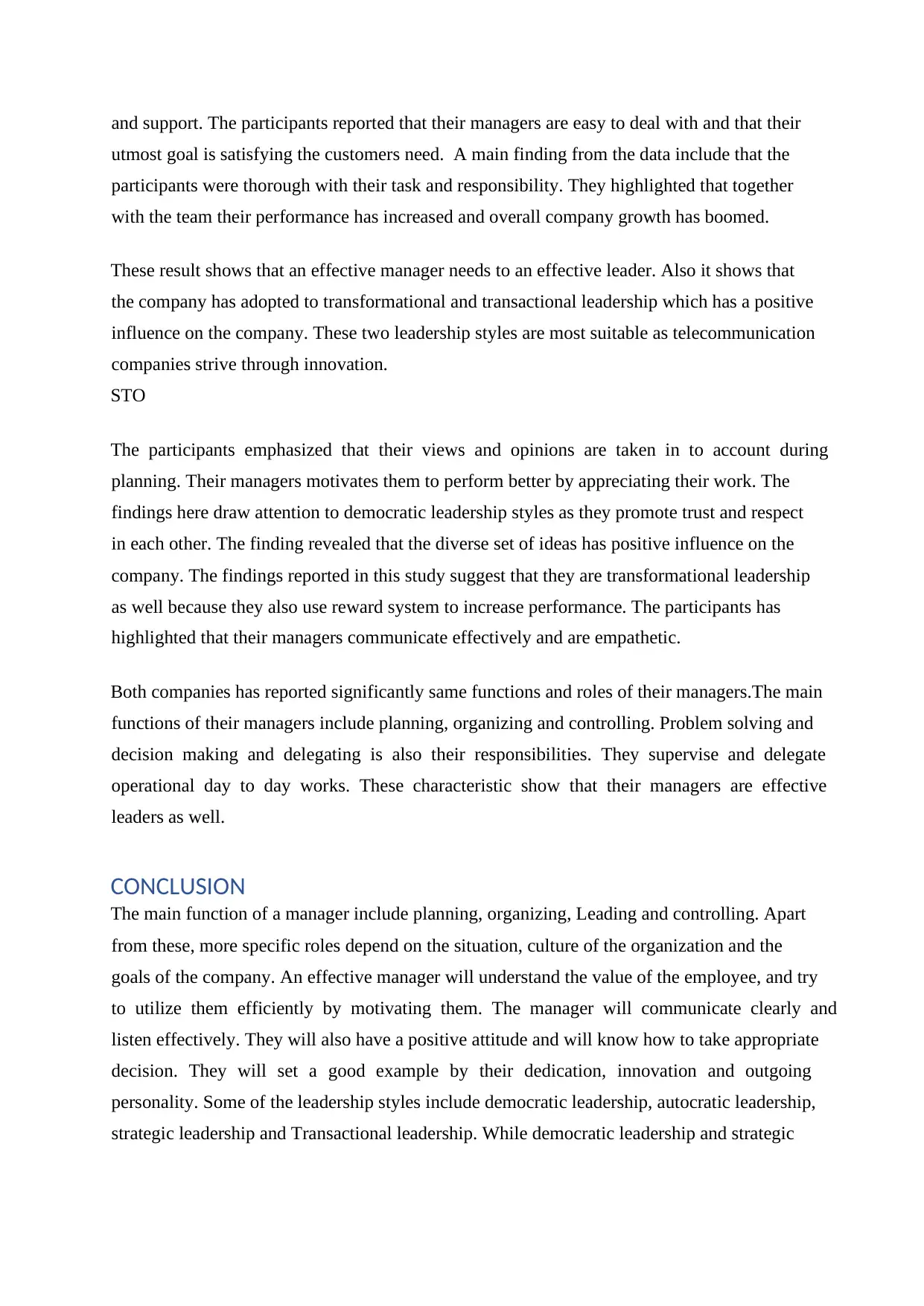
and support. The participants reported that their managers are easy to deal with and that their
utmost goal is satisfying the customers need. A main finding from the data include that the
participants were thorough with their task and responsibility. They highlighted that together
with the team their performance has increased and overall company growth has boomed.
These result shows that an effective manager needs to an effective leader. Also it shows that
the company has adopted to transformational and transactional leadership which has a positive
influence on the company. These two leadership styles are most suitable as telecommunication
companies strive through innovation.
STO
The participants emphasized that their views and opinions are taken in to account during
planning. Their managers motivates them to perform better by appreciating their work. The
findings here draw attention to democratic leadership styles as they promote trust and respect
in each other. The finding revealed that the diverse set of ideas has positive influence on the
company. The findings reported in this study suggest that they are transformational leadership
as well because they also use reward system to increase performance. The participants has
highlighted that their managers communicate effectively and are empathetic.
Both companies has reported significantly same functions and roles of their managers.The main
functions of their managers include planning, organizing and controlling. Problem solving and
decision making and delegating is also their responsibilities. They supervise and delegate
operational day to day works. These characteristic show that their managers are effective
leaders as well.
CONCLUSION
The main function of a manager include planning, organizing, Leading and controlling. Apart
from these, more specific roles depend on the situation, culture of the organization and the
goals of the company. An effective manager will understand the value of the employee, and try
to utilize them efficiently by motivating them. The manager will communicate clearly and
listen effectively. They will also have a positive attitude and will know how to take appropriate
decision. They will set a good example by their dedication, innovation and outgoing
personality. Some of the leadership styles include democratic leadership, autocratic leadership,
strategic leadership and Transactional leadership. While democratic leadership and strategic
utmost goal is satisfying the customers need. A main finding from the data include that the
participants were thorough with their task and responsibility. They highlighted that together
with the team their performance has increased and overall company growth has boomed.
These result shows that an effective manager needs to an effective leader. Also it shows that
the company has adopted to transformational and transactional leadership which has a positive
influence on the company. These two leadership styles are most suitable as telecommunication
companies strive through innovation.
STO
The participants emphasized that their views and opinions are taken in to account during
planning. Their managers motivates them to perform better by appreciating their work. The
findings here draw attention to democratic leadership styles as they promote trust and respect
in each other. The finding revealed that the diverse set of ideas has positive influence on the
company. The findings reported in this study suggest that they are transformational leadership
as well because they also use reward system to increase performance. The participants has
highlighted that their managers communicate effectively and are empathetic.
Both companies has reported significantly same functions and roles of their managers.The main
functions of their managers include planning, organizing and controlling. Problem solving and
decision making and delegating is also their responsibilities. They supervise and delegate
operational day to day works. These characteristic show that their managers are effective
leaders as well.
CONCLUSION
The main function of a manager include planning, organizing, Leading and controlling. Apart
from these, more specific roles depend on the situation, culture of the organization and the
goals of the company. An effective manager will understand the value of the employee, and try
to utilize them efficiently by motivating them. The manager will communicate clearly and
listen effectively. They will also have a positive attitude and will know how to take appropriate
decision. They will set a good example by their dedication, innovation and outgoing
personality. Some of the leadership styles include democratic leadership, autocratic leadership,
strategic leadership and Transactional leadership. While democratic leadership and strategic
⊘ This is a preview!⊘
Do you want full access?
Subscribe today to unlock all pages.

Trusted by 1+ million students worldwide
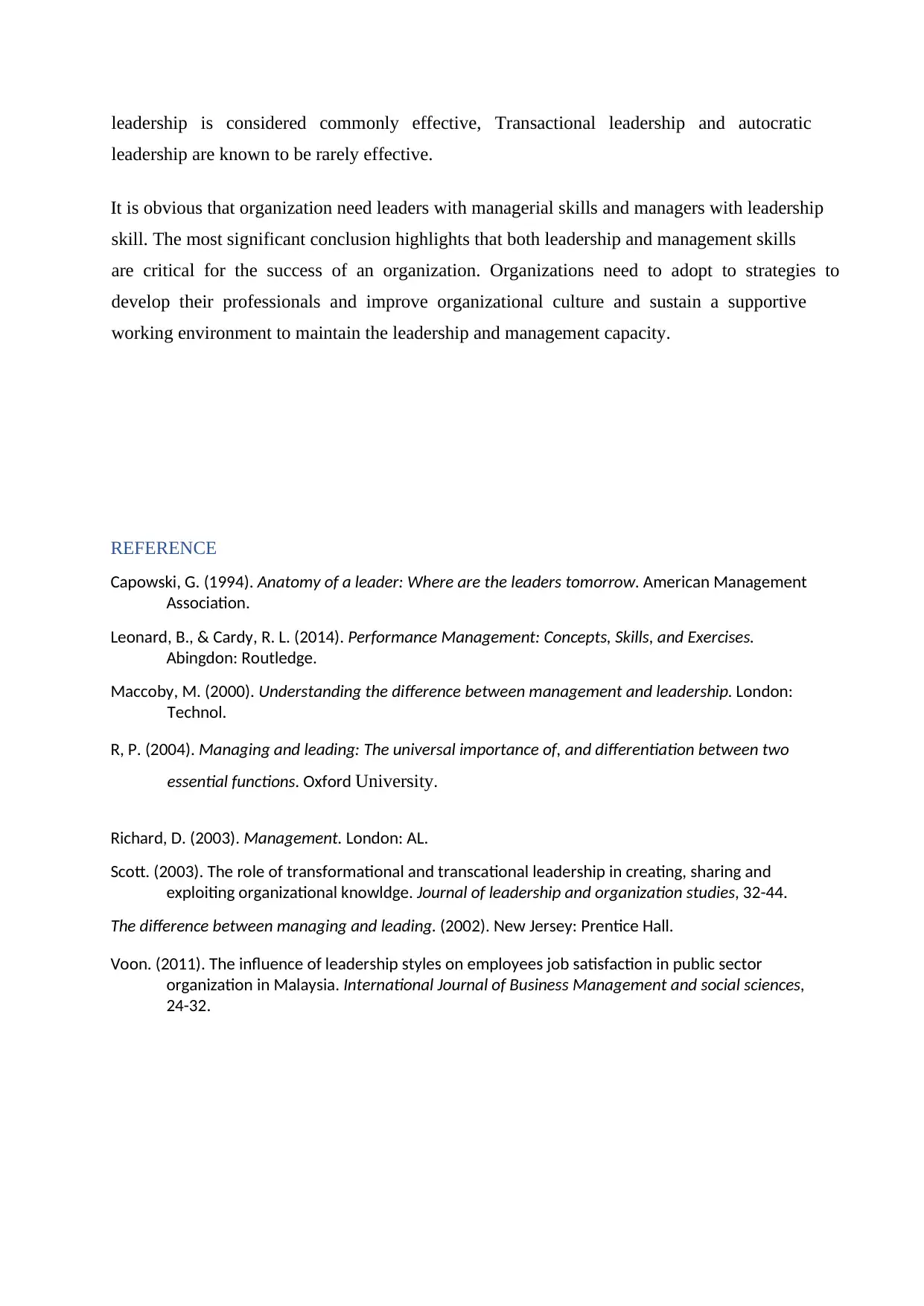
leadership is considered commonly effective, Transactional leadership and autocratic
leadership are known to be rarely effective.
It is obvious that organization need leaders with managerial skills and managers with leadership
skill. The most significant conclusion highlights that both leadership and management skills
are critical for the success of an organization. Organizations need to adopt to strategies to
develop their professionals and improve organizational culture and sustain a supportive
working environment to maintain the leadership and management capacity.
REFERENCE
Capowski, G. (1994). Anatomy of a leader: Where are the leaders tomorrow. American Management
Association.
Leonard, B., & Cardy, R. L. (2014). Performance Management: Concepts, Skills, and Exercises.
Abingdon: Routledge.
Maccoby, M. (2000). Understanding the difference between management and leadership. London:
Technol.
R, P. (2004). Managing and leading: The universal importance of, and differentiation between two
essential functions. Oxford University.
Richard, D. (2003). Management. London: AL.
Scott. (2003). The role of transformational and transcational leadership in creating, sharing and
exploiting organizational knowldge. Journal of leadership and organization studies, 32-44.
The difference between managing and leading. (2002). New Jersey: Prentice Hall.
Voon. (2011). The influence of leadership styles on employees job satisfaction in public sector
organization in Malaysia. International Journal of Business Management and social sciences,
24-32.
leadership are known to be rarely effective.
It is obvious that organization need leaders with managerial skills and managers with leadership
skill. The most significant conclusion highlights that both leadership and management skills
are critical for the success of an organization. Organizations need to adopt to strategies to
develop their professionals and improve organizational culture and sustain a supportive
working environment to maintain the leadership and management capacity.
REFERENCE
Capowski, G. (1994). Anatomy of a leader: Where are the leaders tomorrow. American Management
Association.
Leonard, B., & Cardy, R. L. (2014). Performance Management: Concepts, Skills, and Exercises.
Abingdon: Routledge.
Maccoby, M. (2000). Understanding the difference between management and leadership. London:
Technol.
R, P. (2004). Managing and leading: The universal importance of, and differentiation between two
essential functions. Oxford University.
Richard, D. (2003). Management. London: AL.
Scott. (2003). The role of transformational and transcational leadership in creating, sharing and
exploiting organizational knowldge. Journal of leadership and organization studies, 32-44.
The difference between managing and leading. (2002). New Jersey: Prentice Hall.
Voon. (2011). The influence of leadership styles on employees job satisfaction in public sector
organization in Malaysia. International Journal of Business Management and social sciences,
24-32.
Paraphrase This Document
Need a fresh take? Get an instant paraphrase of this document with our AI Paraphraser
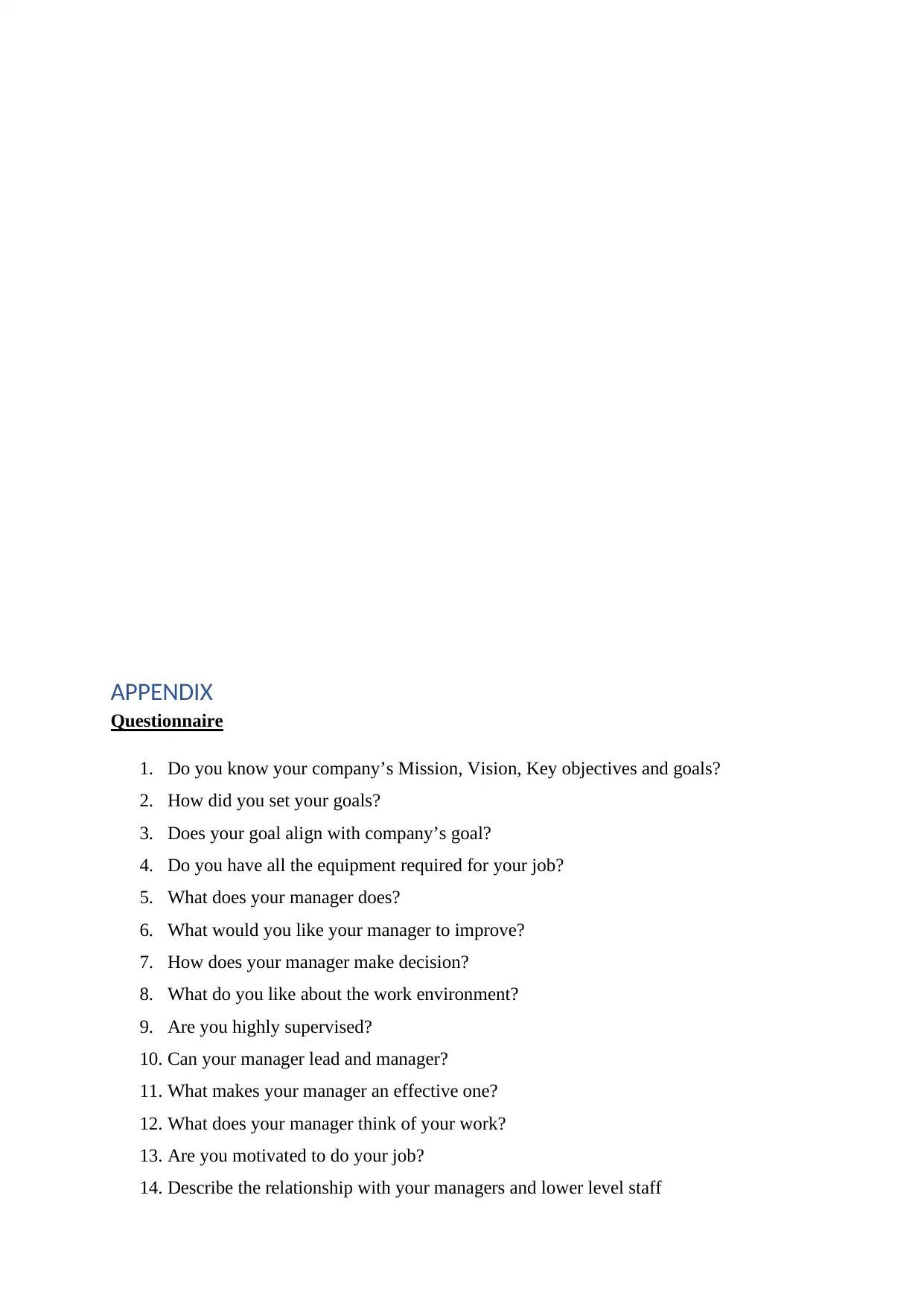
APPENDIX
Questionnaire
1. Do you know your company’s Mission, Vision, Key objectives and goals?
2. How did you set your goals?
3. Does your goal align with company’s goal?
4. Do you have all the equipment required for your job?
5. What does your manager does?
6. What would you like your manager to improve?
7. How does your manager make decision?
8. What do you like about the work environment?
9. Are you highly supervised?
10. Can your manager lead and manager?
11. What makes your manager an effective one?
12. What does your manager think of your work?
13. Are you motivated to do your job?
14. Describe the relationship with your managers and lower level staff
Questionnaire
1. Do you know your company’s Mission, Vision, Key objectives and goals?
2. How did you set your goals?
3. Does your goal align with company’s goal?
4. Do you have all the equipment required for your job?
5. What does your manager does?
6. What would you like your manager to improve?
7. How does your manager make decision?
8. What do you like about the work environment?
9. Are you highly supervised?
10. Can your manager lead and manager?
11. What makes your manager an effective one?
12. What does your manager think of your work?
13. Are you motivated to do your job?
14. Describe the relationship with your managers and lower level staff
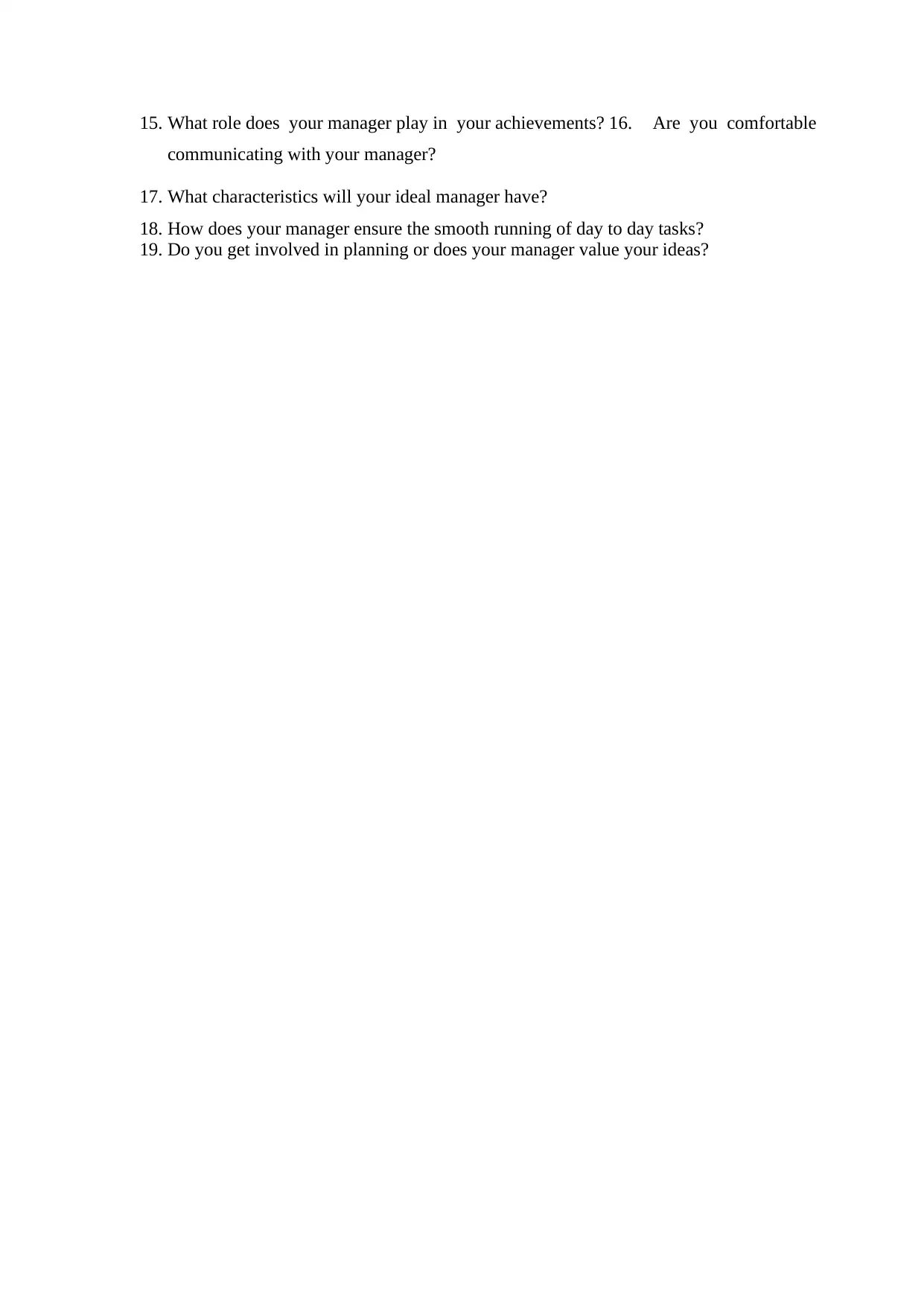
15. What role does your manager play in your achievements? 16. Are you comfortable
communicating with your manager?
17. What characteristics will your ideal manager have?
18. How does your manager ensure the smooth running of day to day tasks?
19. Do you get involved in planning or does your manager value your ideas?
communicating with your manager?
17. What characteristics will your ideal manager have?
18. How does your manager ensure the smooth running of day to day tasks?
19. Do you get involved in planning or does your manager value your ideas?
⊘ This is a preview!⊘
Do you want full access?
Subscribe today to unlock all pages.

Trusted by 1+ million students worldwide
1 out of 12
Related Documents
Your All-in-One AI-Powered Toolkit for Academic Success.
+13062052269
info@desklib.com
Available 24*7 on WhatsApp / Email
![[object Object]](/_next/static/media/star-bottom.7253800d.svg)
Unlock your academic potential
Copyright © 2020–2025 A2Z Services. All Rights Reserved. Developed and managed by ZUCOL.





